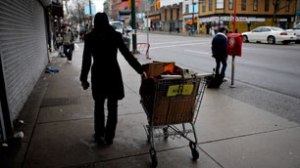As stated in the press release,
“A new research study will help to improve support services aimed at Canadian youth who are homeless or at risk of homelessness, announced Dr. Kellie Leitch, Parliamentary Secretary to the Honourable Diane Finley, Minister of Human Resources and Skills Development.”
This is important for Vancouver because the Downtown Eastside is ground zero for homelessness in Canada. It’s a magnet for the homeless population around the nation, due in part to the support services available and in part due to the most sensible weather in the country to sleep outside. I met a girl named Laura on Tuesday night who was crying in the doorway of a closed cafe because she had come out to Vancouver last month from Halifax. She was 18 years old and had moved here because of the mentioned lure of Vancouver and the promise of being able to stay with friends once she arrived. Those friends had abandoned her almost immediately upon her arrival and she now had no place to stay. She feared that her future was now the streets.
This is an important issue because it is very difficult to make meaningful change in those who have been living homeless for a significant amount of time and are entrenched in the lifestyle. These youth are the next potential generation of homeless, and we have to intervene before they are lost to the Hastings jungle.
Cara Sinclair runs the H.E.L.P. For Street Youth of Canada Society which, in her words “helps these youth through scholarships, thus allowing them to go back to school (trade, vocational, etc.) learn a trade and get off the street.”
She was kind enough to email me back and had the following to say.
“At the age of 19 at-risk youth who may be under the protection/support of social services are essentially cut loose, and they drift away with no one or place to turn to. With no physical, financial or psych direction they end up on the street.”
“Have more centres aimed at helping youth specifically, so they don’t get thrown in with hardened street-entrenched adults. Have more services/access to help them integrate back into society ie) part -time job programs that pay nominally but get them work experience; Additional detox centres. Youth often do drugs to: numb out their pain, stay warm, remove hunger, and stay awake so their few possession don’t get stolen. Somehow we must put things into play to help remove street youths’ perpetual sense of hopelessness. Few see a way out.”

